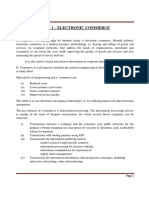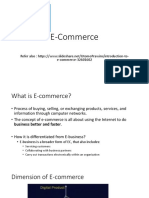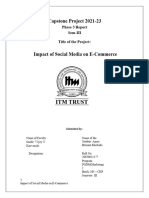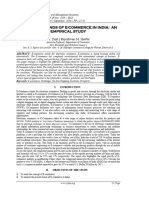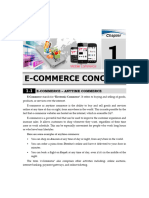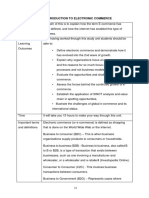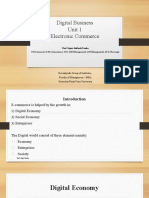unit 1
🌐Aspects
E-Commerce and its Technological
1️⃣Technology
Overview of Developments in Information
(IT)
Information Technology (IT) has played a huge role in the growth of E-Commerce.
💻 Early Stage (1960s–1980s):
Businesses used mainframes and databases for storing sales and
inventory.
Introduction of Electronic Data Interchange (EDI) allowed companies to
exchange invoices, purchase orders, and shipping documents
electronically.
🌍 Internet Era (1990s):
With the rise of the World Wide Web, companies started creating online
storefronts.
Secure online payment methods (credit/debit cards, PayPal) boosted
consumer trust.
📱 Modern Era (2000s–Present):
Widespread use of smartphones and apps for shopping.
Cloud computing, Artificial Intelligence (AI), and Big Data analytics
improved personalization.
New technologies: Blockchain (secure payments), IoT (smart devices),
AR/VR (virtual shopping), and AI chatbots.
👉 Takeaway: IT evolution = backbone of modern e-commerce.
2️⃣
unit 1 1
� 2️⃣ Defining E-Commerce
E-Commerce (Electronic Commerce) = Buying, selling, or exchanging
products/services using the internet or digital networks.
📌 It includes:
Online shopping 🛒
Digital payments 💳
Online ticket booking🎟️
Banking transactions 💰
Digital marketplaces like Amazon, Flipkart, eBay
3️⃣ The Scope of E-Commerce
E-commerce is not limited to just buying & selling online. It covers:
🛍️ B2C (Business to Consumer): Amazon, Flipkart
🏭 B2B (Business to Business): Alibaba, Indiamart
👥 C2C (Consumer to Consumer): OLX, eBay
👨💼 C2B (Consumer to Business): Freelancing sites (Upwork, Fiverr)
🏢 G2C (Government to Citizen): E-Government services like online tax
payment, railway booking
👉 So, scope = huge in business, government, education, healthcare, and
entertainment.
4️⃣ Electronic Market (E-Market)
An Electronic Market is a virtual platform where buyers and sellers interact.
✨ Examples:
E-retail sites: Amazon, Flipkart
Travel booking: MakeMyTrip, IRCTC
Stock/crypto exchanges: NSE, Binance
unit 1 2
� ⚡ Features:
⏰
24/7 availability
Global access 🌎
Comparison shopping 🔍
5️⃣ Electronic Data Interchange (EDI)
EDI = Exchange of structured business documents between companies using
computer networks instead of paper.
📄 Example Documents:
Purchase orders 📝
Shipping notices 🚚
Invoices 📑
✨ Benefits:
Faster transactions ⚡
Fewer errors ✅
Reduced paperwork 📉
6️⃣ Internet Commerce
This is commerce conducted directly over the internet.
Includes:
Online stores 🛍️
Online payment gateways (PayPal, Razorpay, UPI) 💳
Mobile commerce 📱
Online auctions (eBay) 🏷️
7️⃣ Benefits of E-Commerce ✅
unit 1 3
� 🌍 Global reach → Customers worldwide
⏰ 24/7 availability → Shop anytime
📉 Lower costs → No need for physical shops
🔍 Easy product comparison → Better decision making
🤝 Better customer engagement (chatbots, reviews, recommendations)
8️⃣ Limitations of E-Commerce ❌
🔒 Security risks (fraud, hacking)
📦 Logistics challenges (delivery, returns)
❌ No physical inspection of product before buying
🌐 Internet dependency → No internet = no access
🏪 Trust issues in online transactions
9️⃣ Generic Framework for E-Commerce 🏗️
A generic framework explains the basic components of any e-commerce
system:
1. Front-End (User side):
Website/App interface 🖥️
Product catalogs 📚
Shopping cart 🛒
2. Back-End (Business side):
Order management 📦
Payment processing 💳
Inventory control 📊
3. Network Infrastructure:
Internet, servers, cloud hosting 🌐
unit 1 4
� 4. Support Services:
Security 🔐
🚚
Logistics & delivery
Customer support 🤝
🔟 Architectural Framework of E-Commerce
The architecture defines how different layers work together:
Client Side (User):
Web browser, mobile app
Web Server:
Handles user requests
Application Server:
Business logic (shopping cart, checkout, recommendations)
Database Server:
Stores products, users, transactions
Payment Gateway:
Secure online payments
Security Layer:
Encryption (SSL/TLS), authentication
1️⃣1️⃣ Web-Based E-Commerce Architecture 🌐
A web-based e-commerce system is built around:
1. Presentation Layer: User Interface (UI) → website or app
2. Application Layer: Handles product search, cart, and checkout
3. Database Layer: Stores product details, user data, orders
4. Payment Gateway Integration: Secure transactions
unit 1 5
� 5. Delivery & Logistics Integration: Order tracking & shipping
📌 Example Flow:
Customer → Website → Add to Cart → Checkout → Payment → Seller → Delivery
unit 1 6




















